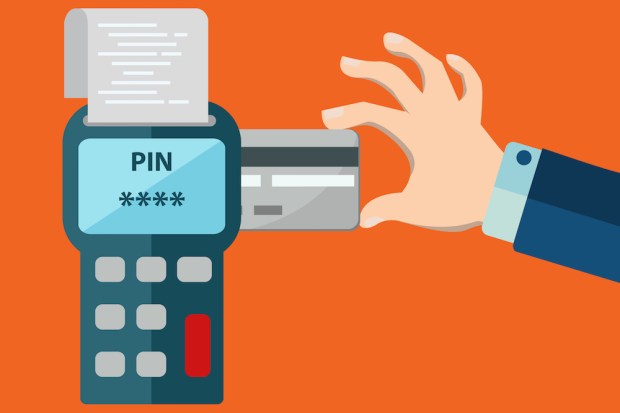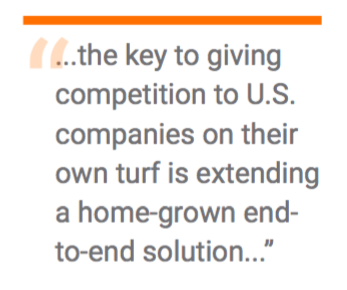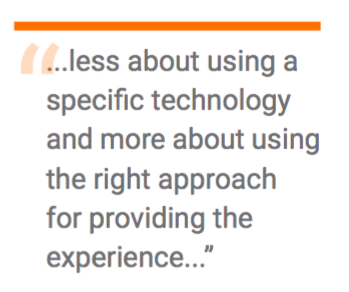European mPOS Player Sees US Opportunity Too Good To Pass Up

The land of mPOS opportunity? Since last October’s EMV liability shift, the U.S. market has captured the attention of several global mPOS providers, including several that once thought the U.S. was too much of a red ocean. For the July edition of the mPOS Tracker™, PYMNTS spoke with SumUp CEO Dan Klein about how EMV changed all that. Catch that, plus the latest news and updates from around the mPOS space, along with a player directory containing the profiles of more than 200 providers.
The onset of the EMV liability shift last October didn’t just make ripples in the U.S. market – it also caught the attention of mPOS players across the pond.
The massive payment infrastructure overhaul, which came with an estimated $8.65 billion price tag, led U.K based-payleven and SumUp, two mobile point of sale solution providers, to invest in the U.S. market. The two companies recently joined forces to extend their presence in 15 countries with over €1 billion in annual processing value.
Now collectively called SumUp, the company is rolling out EMV-enabled mPOS terminals to compete with Square, the big player in the American market that has popularized mPOS solutions with its sleek terminals that are advertised to help businesses process payments on the fly.
“A year-and-a-half ago, I would have actually said, ‘Oh, no, we are not interested in the U.S. market,’” said SumUp CEO Daniel Klein in an interview with PYMNTS. That, however, quickly changed as the slow rollout of the EMV upgrade made headlines. “A lot of companies still have to work through this EMV migration and we still think there’s a huge opportunity.”
Taking a lesson out of Apple’s playbook, Klein said, the key to giving competition to U.S. companies on their own turf is extending a home-grown end-to-end solution — something, he added, that is intended to be innate to SumUp’s product line.
“Nobody, so far, has been able to develop a complete end-to-end technological solution including hardware, payments back end all the way to the acquiring processing,” Klein said. “All the players that we see so far have to rely on different pieces of the product being provided by different vendors.”
Even though the opportunity to profit from the EMV shift is seemingly lucrative, attaining success in the U.S. market isn’t as difficult for a European player as one might imagine, Klein said. “In terms of compliance, I don’t see that today there is actually a lot of competition in the U.S. that has actually good proposition.”
 EMV in the US versus Europe
EMV in the US versus Europe
While EMV adoption and the liability shift in the U.S. falls in line with the rollout in Europe, a benchmark market for post-EMV fraud decline, it differs in the way it was actually implemented in Europe.
In Europe, for instance, EMV transactions are packaged together with PIN security. However, giving way to consumer convenience, the U.S. market has adopted dip and sign. This means that, for European mPOS players, entering the U.S. market essentially demands versioning their products to accommodate the expectations of American consumers.
“For the U.S. market, we simplified it quite significantly,” Klein said. “A very important difference is it doesn’t come with a PIN pad and in Europe we always use a PIN pad.”
The ubiquity of PIN-less chip cards in the U.S. can be estimated by the fact that over 60 percent of Visa’s chip-based credit and debit cards didn’t require PIN or signature until last year.
While currently uncommon, it is projected that the U.S. market will see a larger share of chip and PIN backed transactions by 2025 as merchants like Walmart push for PIN-based transactions for better security.
Extending the right experience
Most American mPOS players depend on third-party processors and vendors to support their functionality and development, which is often designed to serve the needs of large corporate clients, Klein said.
This overlooks the requirements of freelancers and contractors, a workforce segment that has long relied on outdated invoicing methods, which are often paid off by checks.
This friction, he said, can be disrupted by mPOS technology, which can provide a subtle experience through SMS reminders that nudge the payer to complete the transaction.
Klein cited the Apple Store as a prime example of a retail chain that seems to be extending a superior mPOS checkout experience, as its employees are equipped with handheld POS devices to help consumers check out on the go.
Apple’s position toward providing a holistic experience to its customers is less about using a specific technology and more about the using the right approach for providing the experience, and that is something that is applicable to merchants across the board, he said.
“And this goes for relatively small stores, where you (have) two to three salespeople, all the way to large retailers, where you may have 50 or 100 people who ideally should roam around and take PINs from mobile to buy rather than to make people go back to [standing in line] at cash registers.”
The (frictionless) secret sauce
With the changing needs of consumers and the advent of mobile payments technology, POS players often mull too much on getting the technology right for their product line, Klein said. This causes them to push customer acquisition, which Klein believes to be the key to providing the ultimate mPOS experience, to the side.
Emphasizing the absence of a perfect solution for U.S.-based SMBs, Klein said, “the whole customer acquisition piece is being able to target and find customers, reaching customers using, for example, online marketing is something that is absolutely not the norm within acquiring. Nobody really does that,” Klein said.
Customer acquisition, coupled with product simplicity that provides a frictionless experience, is something that will eventually shape the mPOS landscape, he added.
 EMV’s ultimate effect
EMV’s ultimate effect
As the American market takes the leap to embrace EMV technology, fraud is expected to plunge. However, it will likely be some time before the U.S. catches up to the low fraud levels seen in Europe, as its legacy infrastructure gives way to technologically superior POS terminals.
According to PYMNTS’ Q1 SMB Technology Adoption Index, since the liability shift last year, only two-fifths of U.S. SMBs said they use EMV-enabled terminals. The remaining 61 percent either didn’t accept EMV or were unsure about it. Among merchants yet to take the EMV plunge, as many as 49 percent said they would probably not upgrade their terminals, indicating the slow pace of adoption and fraud decline.
“Unfortunately, because there’s still mag stripe usage and because there’s predominant CVM (customer verification method) – still signature, rather than a PIN entry – we do actually still see more fraud in the U.S. It will probably remain like that for years to come, so on a scale of 10 to 1, U.S. to Europe and now it may have been reduced to 2 to 1 or 3 to 1, it’s still higher in risk,” Klein said.
While the advent of EMV cards in the U.S. market is bound to abate fraud activity, the rollout is facing yet another challenge with several merchant locations not accepting chip-based cards, despite being equipped with EMV terminals. The problem, Visa said last month, lies in complex merchant EMV certification.
To help accelerate the certification process, Visa and MasterCard have rolled out new processes that speed up EMV certification.
Other than fraud, a widespread adoption of EMV is also likely to change the daily workflow of merchants. In the restaurant industry, for example, the workflow of today’s dining experience is mostly built around subtly using old-fashioned mag stripe cards. However, with the advent of mPOS technology, it is now possible for restaurants to accept payments right at the table, eliminating the long wait times for billing.
An increasing number of in-app mobile payment solutions for restaurants and vendors are proving to be yet another way for merchants to break away from the conventional payment style — a segment that SumUp is tapping into for breaking into the American market.
The ideal solution to secure mobile payments, however, lies in a better understanding of consumer and merchant mindsets when it comes to using cards and accepting payments, Klein said.
To download the July edition of the PYMNTS.com mPOS Tracker™, click the button below …
About The Tracker
The PYMNTS mPOS Tracker™ is your go-to resource for staying up to date on a month-by-month basis. The tracker highlights the contribution of different stakeholders, including institutions and technology coming together to make this happen.
